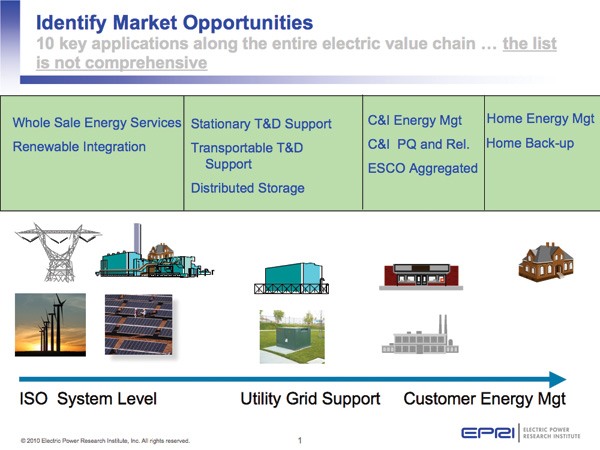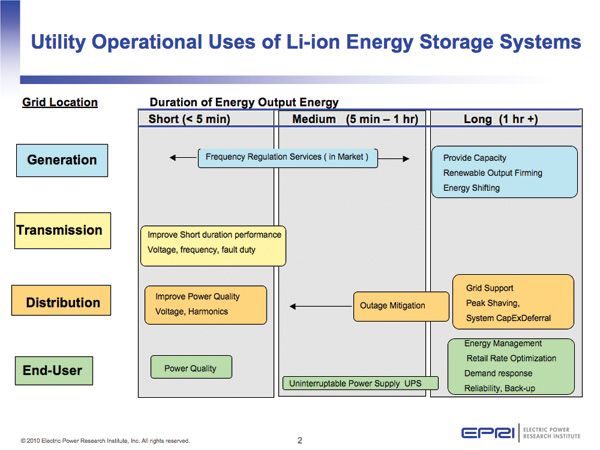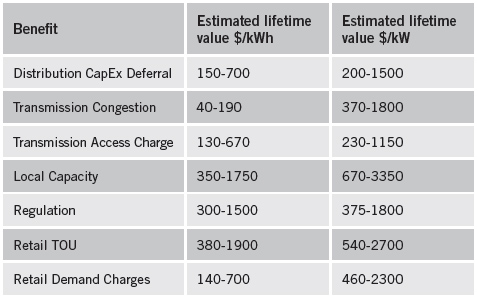A confluence of industry drivers – including increased deployment of variable renewable generation, the high capital cost of managing grid peak demand, and investments in grid infrastructure for reliability and smart grid initiatives – is creating a new interest in utility-scale electric energy storage systems. Just as transmission and distribution (T&D) systems move electricity over distances to end users, energy storage systems can move electricity through time, providing it where and when it is needed. Energy storage systems can help balance variable renewable generation and, properly deployed and integrated, can help increase electric grid reliability and improve asset utilization. With improvements in the cost and commercial availability of energy storage technologies, electricity storage systems may play a pivotal role in influencing the impact of these industry drivers.

Dan Rastler
Program Manager
Energy Storage Program

Haresh Kamath
Project Manager
Technology Innovation
Operational Uses and Applications for Energy Storage
Energy storage systems can provide a variety of operational and energy management solutions, leading to various societal benefits along the entire electrical system value chain. Those solutions range from generation support to transmission and distribution support to end-customer uses. The Electric Power Research Institute (EPRI) is currently analyzing several key applications, as summarized in Figure 1, below. Of course, this list is hardly comprehensive; other energy storage applications exist, and still others may emerge in the future.

Figure 1: Energy Storage Applications along the Electric System Value Chain
Accommodating the Variable Characteristics of Renewable Resources
Renewable energy is fundamentally changing the electricity industry’s strategic landscape. The Energy Information Administration estimates that renewables could account for 17 percent of the electricity produced and delivered in the United States by 2035. Energy storage is one way to give system operators enhanced control over the grid, providing increased operational flexibility to accommodate the increased penetration of renewables. Storage products can provide a variety of services, depending on their power rating, storage capacity, and location.
Bulk storage technologies such as pumped hydro and compressed air energy storage (CAES) systems allow grid operators to store wind and solar energy produced during off-peak periods, for later dispatch into the grid during peak periods when the energy is needed. This capability gives operators control to respond to grid needs across a variety of time frames: From hour-to-hour to meet operational scheduling requirements to ensure power generation capacity is available when required; over a period of several minutes for load following; minute-to-minute for regulation; or in seconds to enhance grid stability.
Although distributed energy storage is more expensive on a per kW basis than bulk storage, it can provide many of the same functions – and more – on a smaller, distributed scale. Flexible, responsive and quiet, batteries and similar storage technologies can be located in distribution systems closer to end users to improve power flow control and grid reliability.
This is especially important in the presence of distributed renewable generation such as rooftop photovoltaic systems. The same storage systems can provide reserve, regulation, and load shifting control to system operators. In the future, it may be possible to aggregate large numbers of dispersed battery systems in smart grid designs to cost-effectively achieve bulk-storage operation.

The Value of Energy Storage Systems
The ability to monetize and bundle energy storage benefits and capture all potential values to support a related business framework acceptable to regulators and utilities is one of the most challenging areas in supporting the business case for storage. In part, this is because the traditional methods used to evaluate the value of conventional generation sources do not adequately capture the range of benefits potentially provided by energy storage systems. On the one hand, storage systems are typically faster and more responsive than conventional generation. On the other, they are “energy limited” resources with limited discharge duration, in contrast to conventional generation systems, which provide power as long as they are provided with fuel.
A recent EPRI study estimated the range of values for the benefits of storage systems. Table 1 (following) presents a summary of the potential range of key benefits identified in the study.

The value of each benefit in this table is calculated for a system delivering 1 MW of power; 2 MWh of storage capacity; 15-year life; and a 10% discount rate, operated so as to provide only that single benefit.
Regulation, system capacity, and deferring capital expenses for transmission or distribution investments potentially provide the highest value for using storage systems. From a customer perspective, using storage to reduce retail time of use charges and demand charges could bring significant value. A key finding confirms that energy storage systems must deliver multiple benefits to justify their relative high cost.
Policy Challenges
The value of energy storage to its users will also be strongly affected by policy. Energy storage systems have characteristics of generation, grid assets, and load, without falling clearly into any of the three categories. This complicates rules for ownership and operation by various entities related to the power industry. Regulatory agencies have not yet defined rules for ownership when storage can be used.
Policy rules regarding allocation of costs incurred by adding storage systems to the grid have not been clearly developed. The bi-directional energy flow complicates fitting storage applications into the range of existing market products, and ultimately, economic benefits will strongly depend on adopted policy and their regulation.
Grid Ready Storage by 2015
No single storage technology can meet all of the applications needs of the power grid, and a wide variety of options are being proposed for utility-scale storage uses. EPRI has identified two leading energy storage technologies for near-term demonstrations: compressed air energy storage (CAES), which could be the most cost-effective bulk storage technology for long discharge (8-10 hrs) duration, and lithium-ion batteries, potentially the most cost-effective option for shorter durations (< 4 hrs). While other energy storage technologies also have technical and economic promise, lithium-ion and CAES each have a clear, broad path to scale production based on other markets, which will bring down the costs of these technologies.
Automakers have turned to lithium-ion batteries to power the new generation of electric vehicles and plug-in hybrid electric vehicles, which are currently being commercialized and readied for mass-market deployment. As a result, lithium-ion batteries have attracted billions of dollars in research and development money, as well as enormous investments in production capacity. Annual production of lithium-ion batteries is projected to achieve more than 30 GWh of storage capacity by 2015.
This new production capacity is expected to drive battery module costs down to less than $300 per kWh, making lithium-ion highly attractive for distributed utility applications. Grid applications can also take advantage of the high energy density, long cycle life, and high efficiency of modern lithium-ion technology.
Regardless of technology, the challenge, in the short term, will be to confirm that the storage products available for utility application are “grid-ready;” that is, they must have a proven track record of safety, performance and reliability in grid-connected applications as well as contain communication and control features required by a smart grid. EPRI’s research aims to answer the questions that utilities, system operators, power producers, and other stakeholders must ask, to enable energy storage products to meet the goals of balancing renewable generation while enhancing grid reliability and asset utilization.
About the Authors
Dan Rastler is the Technical Leader of the Distributed Energy Resources, Energy Storage, and Hydrogen-Electric programs within the EPRI Power Delivery and Utilization Sector, where responsibilities include development, execution, and management of EPRI’s R&D programs focused on distributed resources, energy storage, and hydrogen. He has managed research efforts involving technology assessment and market analysis, electrical integration, and distributed generation and energy storage hardware demonstration projects. Rastler is a world-recognized authority on distributed generation and emerging alternative clean energy technologies. He holds a BS degree in chemical engineering from the University of California at Davis and an MS degree in mechanical engineering from the University of California at Berkeley.
Haresh Kamath is currently serving a stint as a Strategic Program Manager in EPRI’s Technology Innovation Program, where he manages a program investigating advanced materials technologies for grid transformation. He is also a Senior Project Manager in the Power Delivery and Utilization (PDU) Sector where his current research activities focus on the development, assessment, and application of energy storage technologies for both transportation and grid storage applications.
Kamath joined the EPRI Power Electronics Applications Center (PEAC) in 2002 as a project engineer in energy storage and distributed generation. His responsibilities grew to include management of the energy technologies group, encompassing EPRI Solutions efforts in energy storage, distributed generation, energy efficiency, and electric transportation. Kamath was an author for the DOE-EPRI Handbook of Energy Storage and serves on the board of directors of the Electricity Storage Association. He received his Bachelor’s and Master’s degrees in chemical engineering from Stanford University.








